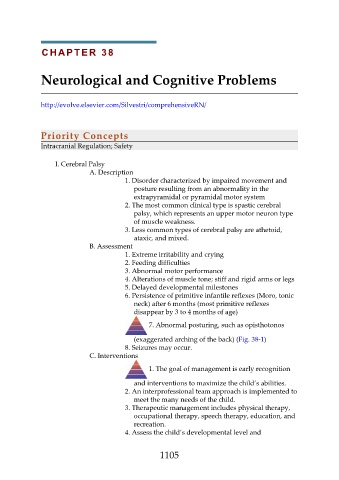Page 1105 - Saunders Comprehensive Review For NCLEX-RN
P. 1105
CHAPTER 38
Neurological and Cognitive Problems
http://evolve.elsevier.com/Silvestri/comprehensiveRN/
Priority Concepts
Intracranial Regulation; Safety
I. Cerebral Palsy
A. Description
1. Disorder characterized by impaired movement and
posture resulting from an abnormality in the
extrapyramidal or pyramidal motor system
2. The most common clinical type is spastic cerebral
palsy, which represents an upper motor neuron type
of muscle weakness.
3. Less common types of cerebral palsy are athetoid,
ataxic, and mixed.
B. Assessment
1. Extreme irritability and crying
2. Feeding difficulties
3. Abnormal motor performance
4. Alterations of muscle tone; stiff and rigid arms or legs
5. Delayed developmental milestones
6. Persistence of primitive infantile reflexes (Moro, tonic
neck) after 6 months (most primitive reflexes
disappear by 3 to 4 months of age)
7. Abnormal posturing, such as opisthotonos
(exaggerated arching of the back) (Fig. 38-1)
8. Seizures may occur.
C. Interventions
1. The goal of management is early recognition
and interventions to maximize the child’s abilities.
2. An interprofessional team approach is implemented to
meet the many needs of the child.
3. Therapeutic management includes physical therapy,
occupational therapy, speech therapy, education, and
recreation.
4. Assess the child’s developmental level and
1105

